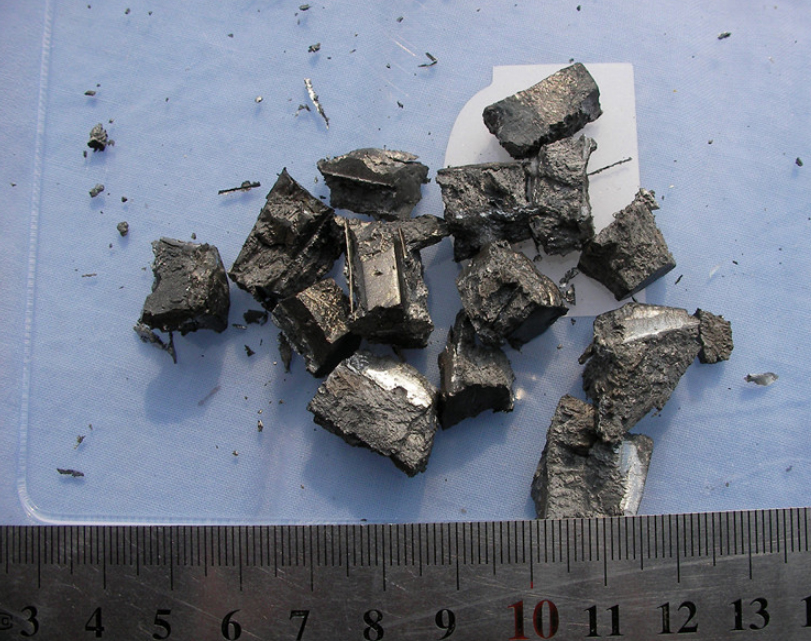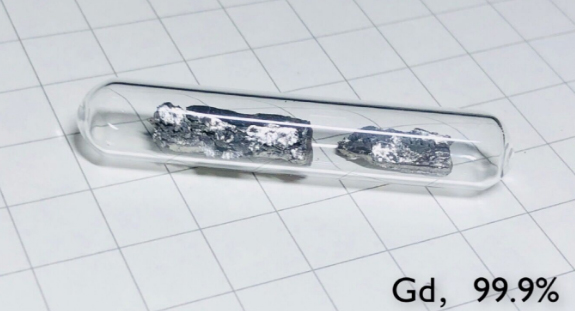Gadolinium metal
Gadolinium is a silver-white metal with ductility. It has a melting
point of 1313°C, a boiling point of 3266°C, and a density of 7.9004
g/cm³. Gadolinium is magnetic at room temperature. Gadolinium is
relatively stable in dry air and loses its luster in moist air;
Gadolinium has the highest thermal neutron capture surface and can be
used as reactor control material and protective material; Gadolinium
salt can be magnetized and refrigerated to obtain ultra-low temperature
close to absolute zero.
Application field
The important property of gadolinium is that there is one electron in
each of the seven orbitals, which is the largest number of unpaired
electrons in rare earth elements. The magnetic moment dependent on this
unpaired electron is the largest, and it can be expected that this
characteristic can be effectively utilized.
medical field:
In medical applications, the gadolinium-diethylenediamine pentaacetic
acid (DTPA) complex can be used as an X-ray contrast agent barium as an
adjustment agent for the intensity of the MRI (magnetic resonance
imaging diagnosis) screen. That is, the use of the water surrounding
gadolinium is affected by the magnetic moment of the gadolinium nucleus,
which shows that the nature of the water is different from that of the
unaffected water. The use of the control screen is conducive to the
diagnosis of the disease.
Industrial field: The well-known industrial technology called magnetic
refrigeration is to heat up when it is changed into a magnet by the
action of a magnetic field, and to remove the heat absorption when the
magnetic field disappears for cooling. It is possible to manufacture
small and efficient refrigerators.
In the magnetic bubble memory device, gadolinium-potassium-garnet is
used as the media material. Magnetic bubble memory is to add a magnetic
field in the vertical direction of the substance to turn it into a
cylindrical magnetic field. The magnetic field is strengthened, and the
phenomenon that the magnetic field disappears soon occurs. The magnetic
bubble memory device can store information, which is generally used for
information collection.
Other uses of gadolinium are for optical fibers and optical discs like
terbium and dysprosium. Magneto-optical recording uses light to replace
the magnetized and unmagnetized parts of magnetic reading. It has the
characteristics of high density and can be rewritten and recorded.
Nuclear energy field: In the atomic energy industry, the large neutron
absorption cross-section of the isotopes of europium and gadolinium is
used as control rods and neutron absorbers for light water reactors and
fast breeder reactors.
The use of gadolinium is a feature of all elements that strongly react
to thermal neutrons. In addition to being used for nuclear reactor
control, invisible neutrons can also be absorbed by gadolinium and made
to emit light, as a fluorescent agent for photosensitivity on X-ray film
use.
specific purpose
Its main uses are:
(1) Its water-soluble paramagnetic complex can improve the human body's
nuclear magnetic resonance (NMR) imaging signal in medical treatment
[8].
(2) Its sulfur oxide can be used as the matrix grid of special
brightness oscilloscope and X-ray phosphor screen.
(3) The gadolinium in the gadolinium gallium garnet is an ideal single
substrate for magnetic bubble memory.
(4) When there is no Camot cycle restriction, it can be used as a solid
magnetic refrigeration medium.
(5) It is used as an inhibitor to control the chain reaction level of
nuclear power plants to ensure the safety of nuclear reactions.
(6) Used as an additive for samarium-cobalt magnets to ensure that the
performance does not change with temperature.
In addition, the use of gadolinium oxide together with lanthanum
contributes to changes in the vitrification zone and improves the
thermal stability of the glass. Gadolinium oxide can also be used to
make capacitors and X-ray intensifying screens. In the world, efforts
are being made to develop the application of gadolinium and its alloys
in magnetic refrigeration, and breakthroughs have been made. Magnetic
refrigerators using superconducting magnets, metal gadolinium or their
alloys as the refrigerating medium at room temperature have come out.
.


Gadolinium is a silver-white metal with ductility. It has a melting
point of 1313°C, a boiling point of 3266°C, and a density of 7.9004
g/cm³. Gadolinium is magnetic at room temperature. Gadolinium is
relatively stable in dry air and loses its luster in moist air;
Gadolinium has the highest thermal neutron capture surface and can be
used as reactor control material and protective material; Gadolinium
salt can be magnetized and refrigerated to obtain ultra-low temperature
close to absolute zero.
Application field
The important property of gadolinium is that there is one electron in
each of the seven orbitals, which is the largest number of unpaired
electrons in rare earth elements. The magnetic moment dependent on this
unpaired electron is the largest, and it can be expected that this
characteristic can be effectively utilized.
medical field:
In medical applications, the gadolinium-diethylenediamine pentaacetic
acid (DTPA) complex can be used as an X-ray contrast agent barium as an
adjustment agent for the intensity of the MRI (magnetic resonance
imaging diagnosis) screen. That is, the use of the water surrounding
gadolinium is affected by the magnetic moment of the gadolinium nucleus,
which shows that the nature of the water is different from that of the
unaffected water. The use of the control screen is conducive to the
diagnosis of the disease.
Industrial field: The well-known industrial technology called magnetic
refrigeration is to heat up when it is changed into a magnet by the
action of a magnetic field, and to remove the heat absorption when the
magnetic field disappears for cooling. It is possible to manufacture
small and efficient refrigerators.
In the magnetic bubble memory device, gadolinium-potassium-garnet is
used as the media material. Magnetic bubble memory is to add a magnetic
field in the vertical direction of the substance to turn it into a
cylindrical magnetic field. The magnetic field is strengthened, and the
phenomenon that the magnetic field disappears soon occurs. The magnetic
bubble memory device can store information, which is generally used for
information collection.
Other uses of gadolinium are for optical fibers and optical discs like
terbium and dysprosium. Magneto-optical recording uses light to replace
the magnetized and unmagnetized parts of magnetic reading. It has the
characteristics of high density and can be rewritten and recorded.
Nuclear energy field: In the atomic energy industry, the large neutron
absorption cross-section of the isotopes of europium and gadolinium is
used as control rods and neutron absorbers for light water reactors and
fast breeder reactors.
The use of gadolinium is a feature of all elements that strongly react
to thermal neutrons. In addition to being used for nuclear reactor
control, invisible neutrons can also be absorbed by gadolinium and made
to emit light, as a fluorescent agent for photosensitivity on X-ray film
use.
specific purpose
Its main uses are:
(1) Its water-soluble paramagnetic complex can improve the human body's
nuclear magnetic resonance (NMR) imaging signal in medical treatment
[8].
(2) Its sulfur oxide can be used as the matrix grid of special
brightness oscilloscope and X-ray phosphor screen.
(3) The gadolinium in the gadolinium gallium garnet is an ideal single
substrate for magnetic bubble memory.
(4) When there is no Camot cycle restriction, it can be used as a solid
magnetic refrigeration medium.
(5) It is used as an inhibitor to control the chain reaction level of
nuclear power plants to ensure the safety of nuclear reactions.
(6) Used as an additive for samarium-cobalt magnets to ensure that the
performance does not change with temperature.
In addition, the use of gadolinium oxide together with lanthanum
contributes to changes in the vitrification zone and improves the
thermal stability of the glass. Gadolinium oxide can also be used to
make capacitors and X-ray intensifying screens. In the world, efforts
are being made to develop the application of gadolinium and its alloys
in magnetic refrigeration, and breakthroughs have been made. Magnetic
refrigerators using superconducting magnets, metal gadolinium or their
alloys as the refrigerating medium at room temperature have come out.
.
 |
 |
|---|---|
